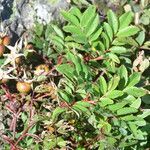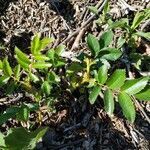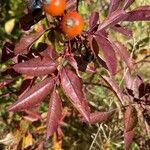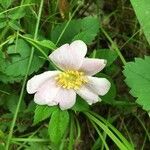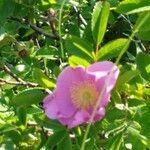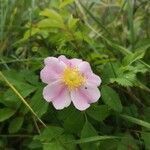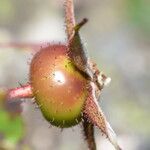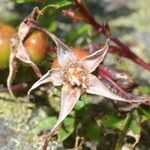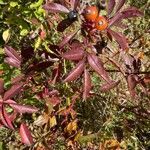Shrubs, forming dense thickets and hedge clusters. Stems erect to ascending, (2–)10–30 dm, densely branched; bark red to purplish red, glabrous; infrastipular prickles paired or single, usually curved, sometimes erect, or declined, appressed, stout, 6–10 × 4–10 mm, ?base glabrous?, internodal prickles or aciculi rare, smaller, sometimes absent. Leaves 5–8(–11) cm; stipules 14–25 × 4–9 mm, auricles flared, 3–5 mm, margins undulate, irregularly glandular-serrate, surfaces glabrous, eglandular; petiole and rachis sometimes with pricklets and aciculi, glabrous, puberulent, or sparsely pubescent, stipitate-glandular; leaflets 5–7(–9), terminal: petiolule 6–14 mm, blade narrowly elliptic to ovate, 17–32 × 6–16 mm, membranous, base cuneate, margins 1–2-serrate, teeth 10–18(–23) per side, gland-tipped or eglandular, apex acute, sometimes obtuse, abaxial surfaces pale green, glabrous or pubescent, eglandular, adaxial deep green, turning purplish red in fall, lustrous, glabrous. Inflorescences corymbs, 1–6(–15)-flowered. Pedicels erect, slender to stout, 7–14(–25) mm, glabrous, sparsely to densely stipitate-glandular; bracts 2, broadly lanceolate, 16–25 × 4–6 mm, margins entire, sometimes serrate, gland-tipped, surfaces glabrous with few hairs, eglandular. Flowers 4.3–5.5 cm diam.; hypanthium subglobose or depressed-globose, sometimes globose, 3.5–5.5 × 5.5–6.5 mm, glabrous, stipitate-glandular, neck absent; sepals spreading or reflexed, lanceolate, 20–40 × 2.5–4 mm, tip 6–12 × 0.5–2 mm, margins usually pinnatifid, rarely entire, inner 2 usually entire, abaxial surfaces glabrous, densely stipitate-or setose-glandular; petals single, pink to deep rose, rarely white, 22–26 × 25–30 mm; ?stamens 140?; carpels 26–40(–65), styles exsert 1–2.5 mm beyond stylar orifice (1.5–3 mm diam.) of hypanthial disc (3–5 mm diam.). Hips orange-red to red or red-black, globose to depressed-globose, 8–12 × 9–13 mm, fleshy, glabrous, stipitate-glandular, neck absent; sepals deciduous, erect. Achenes mostly basal, fewer basiparietal, 8–14, tan, 3–4 × 1.5–3.5 mm. 2n = 28.
More
Stout and branched, to 2 m, scarcely colonial; infrastipular prickles stout, usually somewhat decurved, the flattened base tending to be more than half as long as the prickle; internodal prickles few and similar to the others, or none; stipules usually glandular-dentate, somewhat dilated above, the free part lanceolate to semiovate; lfls usually 7 or 9, glossy, oblong to oval or ovate, often more than half as wide as long, coarsely toothed, the teeth avg ca 1 mm high; fls solitary or few together on branches from old wood; pedicel and hypanthium stipitate-glandular; sep often conspicuously elongate, to 3 cm, with lanceolate foliaceous tip, soon spreading or reflexed, then deciduous; pet pink, 2–3 cm; hips red, 10–15 mm thick; 2n=28. Moist or dry soil; Nf. to Pa. and Va., and inland irregularly to Mo. Hybridizes with R. carolina, R. nitida, and R. palustris. (R. lucida)
Mainly near the coast, growing in grasslands, woods, cliffs, maritime heathlands, ditches, old fields, edges of wet spruce woods, rocky ledges, damp thickets, swamps, streams, shores; at elevations up to 200 metres.
Can be grown by cuttings or seedlings. Seeds needs scarification.
